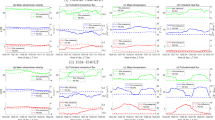Abstract
Structure functions are used to study the dissipation and inertial range scales of turbulent energy, to parametrize remote turbulence measurements, and to characterize ramp features in the turbulent field. Ramp features are associated with turbulent coherent structures, which dominate energy and mass fluxes in the atmospheric surface layer. The analysis of structure functions to identify ramp characteristics is used in surface renewal methods for estimating fluxes. It is unclear how commonly observed different scales of ramp-like shapes (i.e., smaller ramps and spikes embedded in larger ramps) influence structure function analysis. Here, we examine the impact of two ramp-like scales on structure function analysis using artificially generated data. The range of time lags in structure function analysis was extended to include time lags typically associated with isotropic turbulence to those larger than the ramp durations. The Van Atta procedure (Arch Mech 29:161–171, 1977) has been expanded here to resolve the characteristics of two-scale ramp models. This new method accurately, and in some cases, exactly determines the amplitude and duration of both ramp scales. Spectral analysis was applied to the structure functions for a broad range of time lags to provide qualitative support for the expanded Van Atta procedure results. The theory reported here forms the foundation for novel methods of analyzing turbulent coherent structures.
Similar content being viewed by others
References
Antonia RA, Rajagopalan A, Chambers AJ (1983) Conditional sampling of turbulence in the atmospheric surface layer. J Clim Appl Meteorol 22: 69–78
Blackwelder RF, Kaplan RE (1976) On the wall structure of the turbulent boundary layer. J Fluid Mech 76: 89–112
Bloomfield P (2000) Fourier analysis of time series. Wiley, New York, 288 pp
Chen W, Novak MD, Black TA (1997a) Coherent eddies and temperature structure functions for three contrasting surfaces. Part I: Ramp model with finite microfront time. Boundary-Layer Meteorol 84: 99–123
Chen W, Novak MD, Black TA (1997b) Coherent eddies and temperature structure functions for three contrasting surfaces. Part II: Renewal model for sensible heat flux. Boundary-Layer Meteorol 84: 125–147
Collineau S, Brunet Y (1993a) Detection of turbulent coherent motions in a forest canopy. Part I: Wavelet analysis. Boundary-Layer Meteorol 65: 357–379
Collineau S, Brunet Y (1993b) Detection of turbulent coherent motions in a forest canopy. Part II: Time-scales and conditional averages. Boundary-Layer Meteorol 66: 49–73
Gao W, Shaw RH, Paw U KT (1989) Observations of organized structure in turbulent flow within and above a forest canopy. Boundary-Layer Meteorol 47: 349–377
Lenschow DH (1986) Probing the atmospheric boundary layer. American Meteorological Society, Boston, 269 pp
Monin AS, Yaglom AM (1975) Statistical fluid mechanics II. MIT Press, Cambridge, 874 pp
Paw U KT (2001) Coherent structures and surface renewal. In: Rossi F, Duce P, Spano D (eds) Advanced short course on agricultural forest and micro meteorology. Consiglio Nazionale delle Richerche, Sassari, 304 pp
Paw U KT, Brunet Y, Collineau S, Shaw RH, Maitani T, Qui J, Hipps L (1992) On coherent structures in turbulence above and within agricultural plant canopies. Agric For Meteorol 61: 55–68
Paw U KT, Qiu J, Su HB, Watanabe T, Brunet Y (1995) Surface renewal analysis: a new method to obtain scalar fluxes without velocity data. Agric For Meteorol 74: 119–137
Paw U KT, Snyder RL, Spano D, Su HB (2005) Surface renewal estimates of scalar exchange. In: Hatfield JL (ed) Micrometeorology of agricultural systems. Agronomy Society of America, Madison, 584 pp
R Development Core Team (2012) R: A language and environment for statistical computing. R Foundation for Statistical Computing, Vienna. ISBN3-900051-07-0
Shapland TM, McElrone AI, Snyder RL, Paw U KT (2012) Structure function analysis of two-scale scalar ramps. Part II: Ramp characteristics and surface renewal flux estimation. Boundary-Layer Meteorol 145 (this issue)
Snyder RL, Spano D, Paw U KT (1996) Surface renewal analysis of sensible and latent heat flux density. Boundary-Layer Meteorol 77: 249–266
Snyder RL, Paw U KT, Spano D, Duce P (1997) Surface renewal estimates of evapotranspiration. Acta Hortic 449: 49–55
Spano D, Snyder RL, Duce P, Paw U KT (1997) Surface renewal analysis for sensible heat flux density using structure functions. Agric For Meteorol 86: 259–271
Spano D, Snyder RL, Duce P, Paw U KT (2000) Estimating sensible and latent heat flux densities from grapevine canopies using surface renewal. Agric For Meteorol 104: 171–183
Stull RB (1988) An introduction to boundary layer meteorology. Kluwer Academic Publishers, Dordrecht, 666 pp
Thomas C, Mayer JC, Meixner FX, Foken T (2006) Analysis of low-frequency turbulence over tall vegetation using a Doppler sodar. Boundary-Layer Meteorol 119: 563–587
Van Atta CW (1977) Effect of coherent structures on structure functions of temperature in the atmospheric boundary layer. Arch Mech 29: 161–171
Wyngaard JC (1973) On surface-layer turbulence. In: Haugen DA (ed) Workshop on micrometeorology. American Meteorological Society, Boston, pp 101–149
Wyngaard JC (2010) Turbulence in the atmosphere. Cambridge University Press, Cambridge, 393 pp
Wyngaard JC, Lemone MA (1980) Behavior of the refractive index structure parameter in the entraining boundary layer. J Atmos Sci 37: 1573–1585
Wyngaard JC, Cote OR, Izumi Y (1971) Local free convection, similarity, and the budgets of shear stress and heatflux. J Atmos Sci 28: 1171–1182
Author information
Authors and Affiliations
Corresponding author
Rights and permissions
About this article
Cite this article
Shapland, T.M., McElrone, A.J., Snyder, R.L. et al. Structure Function Analysis of Two-Scale Scalar Ramps. Part I: Theory and Modelling. Boundary-Layer Meteorol 145, 5–25 (2012). https://doi.org/10.1007/s10546-012-9742-5
Received:
Accepted:
Published:
Issue Date:
DOI: https://doi.org/10.1007/s10546-012-9742-5




